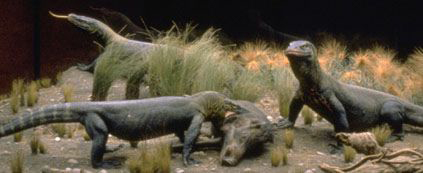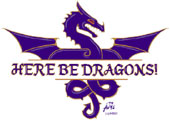|
|
Komodo Dragon - Hunting
Hunting & Diet

The Land Of The Dragons
The conditions are far from hospitable. Steep hills, rocky ground and shallow soil make up the landscape of the dragons' home. Fires and long droughts are common. Rain is sparse, averaging 800mm on a good year. Temperatures can reach 40-43degC after the dry season.
In the harsh environment of these islands, food is not easy to come by. Reptiles have the advantage in the race for the top predator status under these conditions because they have a much lower total energy requirement than mammals.
Adaptations to the habitat
The Komodo dragon has many fascinating adaptations to survive in the harsh, rugged islands.
The Komodo uses the food it eats very efficiently. They eat almost everything of their prey and extract almost all nutrition from what they eat. So they don't need to feed often. It appears that in the wild, the dragons eat very well about once a month. They only eat a few small tidbits between these larger irregular meals.
 |
In addition, the Komodo dragon can put away large quantities of food in a short time. In an environment where food is hard to come by, the Komodo dragon needs to eat as much as possible when it can. And it has to do this fast before other, possibly bigger Komodo dragons arrive at the scene. To swallow huge chunks of meat, like a snake, the dragon has movable joints in its skull and jaws that allow the lower jaw to be opened unusually wide. Its throat and jaw muscles allow it to swallow huge chunks of meat rapidly. The stomach also expands easily, allowing this huge intake of food--up to 80% of its starved body weight in one sitting! A 50kg animal is recorded to have consumed a 31kg pig in just 17 minutes!
|
Komodo dragons rarely need to drink. They get 85% of their liquid from their prey, another adaptation of their efficient digestive system to their dry environment. Very little fluid is excreted.
What does it eat?
The Komodo dragons are totally carnivorous and will eat anything they can overpower. While smaller Komodos have to be content with eggs, lizards, snakes and rodents, the larger ones hunt deer, wild pigs, water buffalos and even horses. Komodo dragons are cannibalistic, and adults will prey on young ones as well as old and sick dragons. Other dragons may make up to 10% of a dragon's diet. There are few verified accounts of dragons actually attacking living humans to eat them, although like any other animal, they will attack in self-defense. |
 |
Lean mean eating machine
While a mammalian predator might leave behind 25 - 30% of the kill, the Komodos consume almost everything, including fur, feathers, hoofs and antlers. Only the herbivorous contents of the stomach and intestines are left behind. Komodos also have a very efficient digestive system. Everything is digested and only 8-13% is excreted. In a mammalian predator like the tiger, this figure may be 32-37%.
As a result, Komodos can survive on far less food. Captive dragons consume only about 156kg of meat a year (and captives are often overweight). In comparison, a mammalian predator like the wolf, weighing about half that of an adult Komodo, needs about 1,227kg of meat a year.
Dragon on the hunt

The Komodo dragon is an avid hunter. But if sufficient food is available, scavenging is generally preferred as it takes less energy than hunting.
Komodo dragons are among the smartest lizards. Like other hunters, they have learned hunting skills and the behavior of their prey. In addition, they have acute hunting senses. The Komodo's keen sense of smell is its primary food detector. It can detect dead animals up to 8.5km away upwind. When it arrives at the food source, it will not eat until it has touched the potential food with its tongue. Dragons also have good eyesight and can see as far away as 300m. Their eyes are better at picking up movement than at discerning stationary objects. Their retinas possess only cones, so they may be able to distinguish color but have poor vision in dim light. Once thought to be deaf, dragons do hear but a limited range, probably between 400 to 2000 hertz. They are insensitive to low-pitched voices and high-pitched screams.
Although dragons may forage for up to 10 km/day, they often hunt by what is sometimes called the lurk n' lurch method. They lie, well camouflaged and motionless, along game paths used by animals going to waterholes. When the prey animal is about a metre away, the Komodo ambushes it. If the prey is a large animal, the Komodo dragon goes for the leg, tearing the hamstring. When the animal is down, it then goes for the throat and belly. If the prey if small, it goes directly for the throat and belly. It can also disembowel prey with its powerful clawed feet. Dragons are good swimmers and may swim the long distance from one island to another. Like other monitors, they swim by undulating their tails, their legs held against their bodies. They can also dive and stay underwater, some say up to 100m.
Back: Komodo Dragon
Continue: Komodo Dragon Mating
Source of Information
Images starting with Otto are Copyrighted by Otto de Voogd.
What did you think about the Komodo Dragon?
Send us E-Mail!
|
| |
|
|
If you enjoyed information on our Draconian site, please link to us.
All images and content are copyright © 1996-2024 Draconian.com
Any reprinting or use of the materials on this site without express permission is prohibited
Please report any suspected copyright infringement to
contactdraconian@gmail.com
|
|



